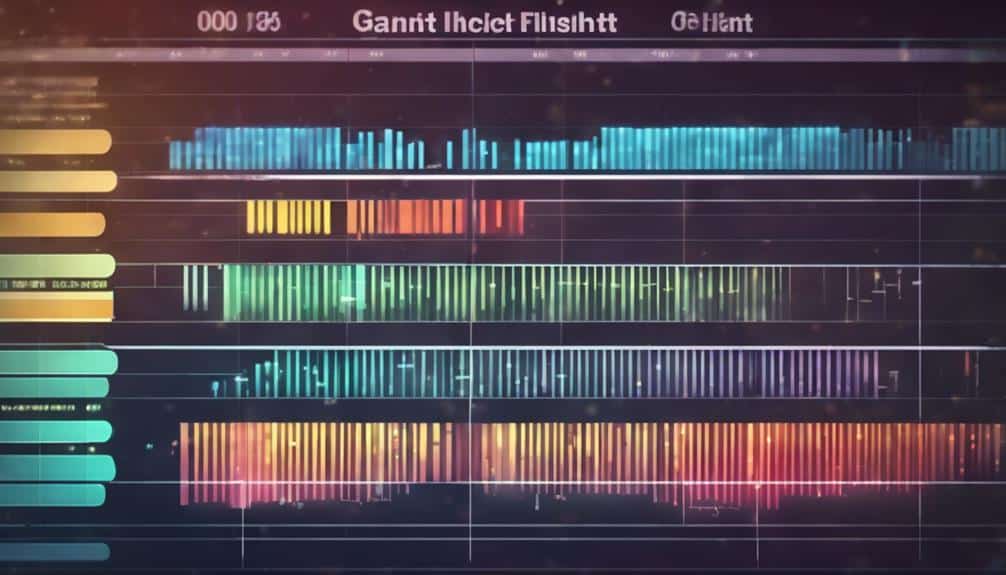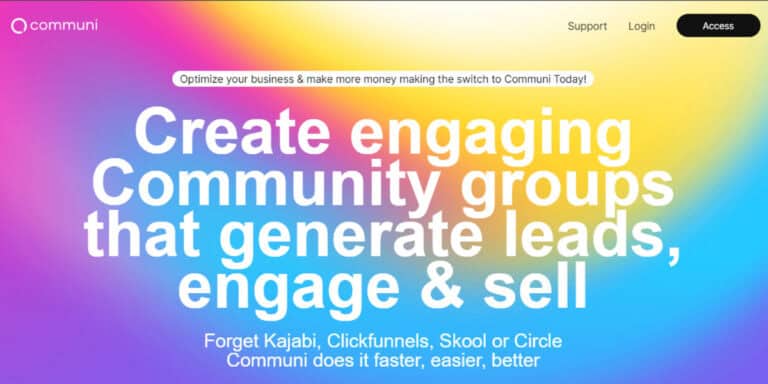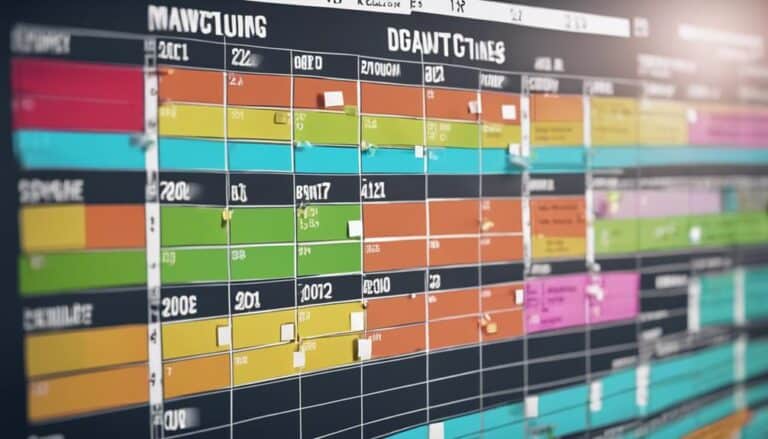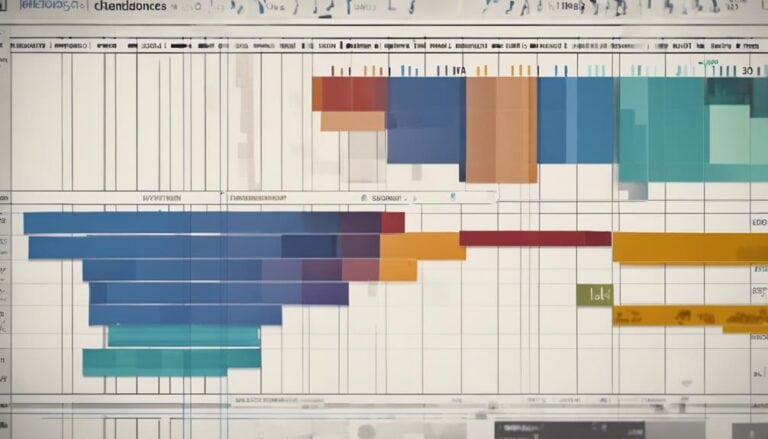When managing complex projects, you need a tool that provides clarity, organization, and efficiency. Gantt charts offer a visual roadmap that simplifies project timelines and tasks, but their value extends beyond mere organization.
By utilizing Gantt charts for project scheduling, you not only enhance your planning capabilities but also empower your team to work collaboratively towards a common goal.
The benefits of incorporating Gantt charts into your project management arsenal are numerous, and they can significantly impact the success of your endeavors.
Key Takeaways
- Comprehensive visual representation of project timelines and task dependencies
- Real-time progress updates and communication for swift decision-making
- Identifying bottlenecks and streamlining resource allocation efficiently
- Optimizing task dependencies, sequencing, and project planning for enhanced efficiency
Benefits of Gantt Charts
Gantt charts offer a comprehensive visual representation of project timelines and task dependencies, aiding in effective project management strategies. The benefits of using Gantt charts for project scheduling are numerous. Firstly, they provide a clear overview of the project timeline, allowing you to see all tasks at a glance and understand the order in which they need to be completed.
This visual representation helps in planning and allocating resources required for each task, ensuring that nothing falls through the cracks. By highlighting task dependencies, Gantt charts enable you to identify critical paths and prioritize work accordingly. This not only streamlines the project scheduling process but also helps in avoiding bottlenecks and delays.
Moreover, Gantt charts enhance communication within the team, promoting accountability and transparency. Overall, the structured layout and functionality of Gantt charts significantly contribute to the success of project scheduling and management.
Enhanced Project Tracking and Monitoring
When using Gantt charts, you can receive real-time progress updates, swiftly identifying bottlenecks to ensure smooth project flow.
By streamlining resource allocation through Gantt charts, you can optimize efficiency and keep your project on track.
These tools aid in visually tracking and monitoring your project's progress, enhancing your scheduling success.
Real-Time Progress Updates
Enhancing project tracking and monitoring through real-time progress updates can significantly improve the efficiency and effectiveness of project management. By utilizing Gantt charts, project managers can have a clear visual representation of task statuses, enabling them to track progress accurately.
Real-time updates on these charts allow immediate insight into which tasks are on track and which ones are facing delays. This visibility helps in making informed decisions promptly, ensuring that project deadlines are met.
Moreover, the visual representation provided by Gantt charts enhances communication among team members and stakeholders by offering a comprehensive overview of the project status. This real-time tracking mechanism empowers project managers to stay proactive and maintain project momentum.
Identify Bottlenecks Quickly
To swiftly address project delays and maintain efficient workflow transitions, the identification of bottlenecks plays a crucial role in enhancing project tracking and monitoring. Gantt charts are instrumental in spotting bottlenecks promptly. Here's how they help:
- Highlighting Delays: Gantt charts pinpoint tasks causing delays in project timelines.
- Visualizing Dependencies: They offer a clear visual representation of task dependencies.
- Timely Interventions: By detecting critical points, bottlenecks can be efficiently addressed.
- Enhanced Monitoring: The insights from Gantt charts aid in maintaining project schedules.
Utilize the power of Gantt charts to identify bottlenecks swiftly, ensuring smoother workflow transitions and project success.
Streamline Resource Allocation
How can Gantt charts streamline resource allocation for enhanced project tracking and monitoring?
Gantt charts play a crucial role in optimizing resource allocation by visually mapping out task assignments and deadlines. This visual representation enables project managers to clearly see resource availability and utilization, leading to efficient resource management. By utilizing Gantt charts, project timelines can be optimized through the effective allocation of resources.
Making decisions regarding resource allocation becomes more manageable with the structured layout provided by Gantt charts, aiding in better project scheduling. Moreover, real-time monitoring of resource allocation allows for quick adjustments, ensuring that resources are utilized effectively to enhance project success.
Gantt charts are instrumental in streamlining resource allocation for improved project tracking and monitoring.
Improved Project Timeline Visualization
When implementing Gantt charts, you can benefit from clear timeline visualization, aiding in enhanced task coordination.
The visual representation of task start dates and durations helps in organizing and structuring project timelines efficiently.
Clear Timeline Visualization
For enhanced project clarity and improved coordination, incorporating a clear timeline visualization through Gantt charts is essential. Gantt charts offer a comprehensive overview of project timelines, task dependencies, milestones, and deadlines. Here's why they're crucial:
- Visual Representation: Gantt charts provide a clear visual representation of project timelines and schedules.
- Understanding Dependencies: They help in understanding task dependencies, durations, and critical path analysis.
- Identifying Milestones: Project milestones and deadlines are easily identifiable using Gantt charts.
- Enhanced Communication: The visualization provided by Gantt charts enhances project communication and coordination among team members.
Enhanced Task Coordination
To enhance task coordination and improve project timeline visualization, integrating Gantt charts is instrumental for effective project management.
Gantt charts offer a visual representation of project timelines, aiding in better coordination among team members. They clearly outline task dependencies, durations, and deadlines, ensuring efficient project scheduling.
By mapping out schedules and milestones visually, Gantt charts help in coordinating tasks effectively for project success. The visual nature of Gantt charts allows for easy identification of overlapping tasks and potential bottlenecks, contributing to improved task coordination and timeline management.
Utilizing Gantt charts provides a comprehensive view of project progress, enhancing communication and alignment within the team. Incorporating Gantt charts into project management processes can significantly improve task coordination and overall project efficiency.
Increased Team Efficiency and Collaboration
Increase your team's efficiency and collaboration by utilizing Gantt charts for streamlined task allocation and clear timelines. Gantt charts play a crucial role in enhancing team efficiency and fostering collaboration by providing a visual representation of project timelines and tasks. Here's how they can benefit your team:
- Efficient Task Allocation: Gantt charts help in assigning tasks to team members clearly, ensuring everyone knows their responsibilities.
- Improved Collaboration: Clear timelines displayed in Gantt charts promote collaboration among team members, allowing for better coordination and communication.
- Progress Tracking: Team members can easily track progress, dependencies, and milestones within the Gantt chart, enabling effective monitoring of the project's advancement.
- Real-Time Updates: Gantt charts facilitate real-time updates, keeping the team aligned and enabling quick adaptations to changes in the project scope or schedule.
Effective Resource Allocation and Management
Enhancing your team's productivity and performance, effective resource allocation and management with Gantt charts play a pivotal role in ensuring project success. Gantt charts assist in allocating resources efficiently, ensuring tasks are delegated appropriately, and team resources are managed effectively. By distributing work evenly among team members, these charts contribute to timely project completion. Optimal resource allocation is key to enhancing team productivity and performance, as it helps in preventing resource overloading or underutilization.
Gantt charts also facilitate tracking and monitoring of resource usage throughout the project lifecycle. This tracking capability enables project managers to visualize resource allocation in real-time, making it easier to identify any potential bottlenecks or issues that may arise. Effective resource management with Gantt charts is crucial for maintaining project timelines and preventing delays in project execution. By utilizing Gantt charts for resource allocation and management, you can streamline your project processes and maximize your team's efficiency.
Enhanced Communication and Coordination
Improving project communication and coordination is essential for achieving successful outcomes, with Gantt charts serving as valuable tools in facilitating these aspects. Gantt charts enhance communication by clearly outlining task dependencies and timelines, reducing misunderstandings among team members. They also play a crucial role in coordinating team efforts by providing a visual representation of project progress. This visual aid helps in assigning tasks effectively and tracking their completion, thereby streamlining coordination. The clear visualization in Gantt charts fosters better collaboration among team members and ensures everyone is on the same page regarding project schedules.
- Gantt charts outline task dependencies and timelines clearly.
- They reduce misunderstandings among team members.
- Gantt charts aid in coordinating team efforts by providing a visual representation of project progress.
- Visualization in Gantt charts fosters better collaboration and ensures alignment on project schedules.
Optimized Task Dependencies and Sequencing
Utilizing Gantt charts facilitates the identification and logical sequencing of task dependencies, optimizing project execution efficiency. Gantt charts visually represent the relationships between tasks, ensuring that each step is completed in the correct order to maintain project flow and prevent bottlenecks. By outlining task dependencies, these charts streamline project scheduling by highlighting critical tasks and their interconnections. Clear sequencing of tasks in Gantt charts enhances project efficiency by minimizing the risk of errors or oversights in task execution. Below is a table illustrating how Gantt charts help in optimizing task dependencies and sequencing for improved project execution:
| Benefits | Description |
|---|---|
| Identifying task dependencies | Clearly see which tasks are dependent on others, aiding in planning the project timeline efficiently. |
| Sequencing tasks logically | Determine the order in which tasks should be completed, avoiding delays and ensuring smooth progress. |
| Highlighting critical tasks | Prioritize essential tasks to prevent project bottlenecks and ensure that key milestones are met. |
| Minimizing risks of errors | Reduce the chances of mistakes by following a structured sequence of tasks outlined in the chart. |
| Enhancing project efficiency | Improve overall project efficiency by maintaining a clear overview of task dependencies and order. |
Streamlined Project Planning and Execution
To streamline project planning and execution effectively, start by harnessing the visual representation capabilities of Gantt charts to map out task timelines and dependencies. Gantt charts are powerful tools in project management that offer numerous benefits to ensure successful project completion. Here are some key ways Gantt charts contribute to streamlined project planning and execution:
- Efficient task allocation: Gantt charts enable you to allocate tasks to team members with clarity, ensuring that everyone knows their responsibilities.
- Resource management: By visually displaying task dependencies and timelines, Gantt charts help in effectively managing resources to meet project deadlines.
- Identifying critical tasks: Gantt charts assist in identifying critical project tasks, allowing you to prioritize and focus on essential activities.
- Progress monitoring: These charts provide a clear overview of task progress, enabling you to track milestones and ensure the project stays on schedule.
Achieving Project Milestones and Objectives
Harnessing the power of Gantt charts enhances project management efficiency by visualizing task timelines and dependencies, aiding in achieving project milestones and objectives. Gantt charts provide a clear overview of the project schedule, allowing you to track progress towards key milestones effectively. By outlining task dependencies, these charts help you prioritize activities to ensure timely completion of project objectives. Additionally, Gantt charts assist in identifying critical path tasks, which are vital for meeting project deadlines. The visual representation of project schedules in Gantt charts enhances project planning, enabling you to strategize and execute tasks efficiently for successful milestone completion.
| Benefits of Gantt Charts for Achieving Project Milestones | How They Help |
|---|---|
| Visual representation of tasks and deadlines | Easily track progress towards milestones |
| Task dependency identification | Prioritize activities for timely completion |
| Critical path analysis | Identify essential tasks for meeting project deadlines |
Frequently Asked Questions
Why Is the Gantt Chart Important in Project Scheduling?
In project scheduling, the Gantt chart is crucial. It helps you manage task dependencies, track timelines visually, allocate resources effectively, and enhance efficiency. By providing clear insights into project progress, it aids in successful scheduling.
What Are the 3 Main Benefits of Using a Gantt Chart?
When using a Gantt chart, you benefit from visualizing task dependencies, managing resource allocation efficiently, and tracking progress effectively. It becomes your go-to tool for improved time management, project coordination, and communication.
What Is the Main Purpose of a Gantt Chart Is to Display the Schedule of Activities?
When using a Gantt chart, you can easily track task progress, visualize timelines, allocate resources efficiently, track dependencies, and manage time effectively. It provides a clear view of project activities, aiding in successful scheduling.
Why Is It Important to Use a Gantt Chart When Planning an Event?
When planning an event, using a Gantt chart is crucial. It ensures efficient event coordination, time management, task visualization, resource allocation, and progress tracking. By utilizing Gantt charts, you enhance organization and optimize your event planning process.
Conclusion
In conclusion, utilizing Gantt charts for project scheduling success is like having a roadmap to guide you through a complex journey.
With clear task dependencies, real-time updates, and streamlined planning, Gantt charts enhance project tracking, team collaboration, and overall efficiency.
By staying organized and strategic, you can effectively manage resources, communicate effectively, and achieve project milestones with ease.
So, embrace the power of Gantt charts and watch your projects soar to success!





